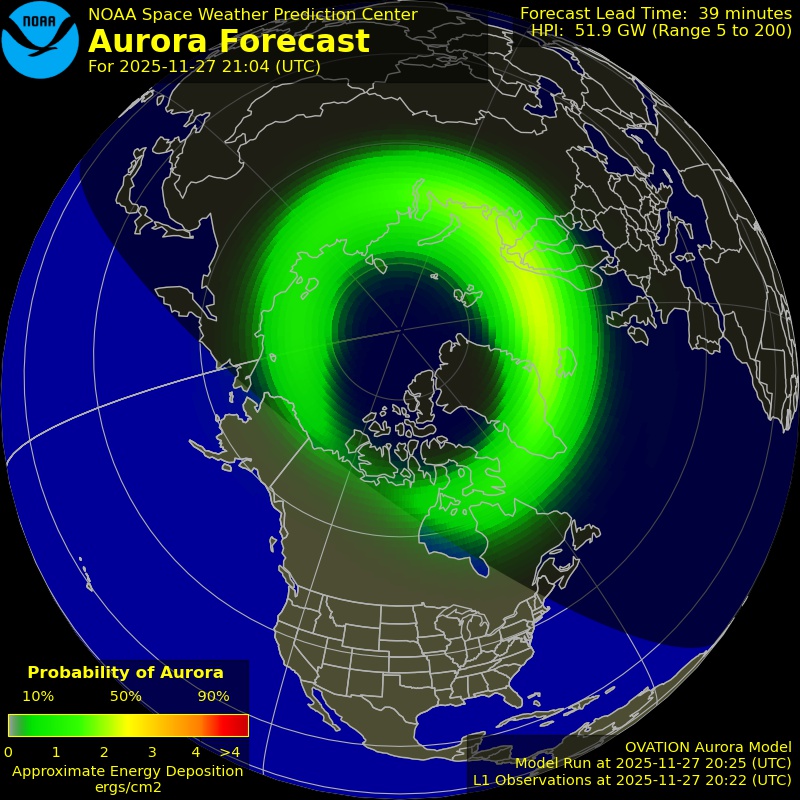Northern Lights Forecast for Alberta
Ideal Conditions for Northern Lights in Alberta:
Power: +20 Gw | Bz: -1.5 | Wind Speed: 400+ | Density: 4+ | Kp: 2+
Auroras have been known to show in Alberta with little strength up in the northern parts of the province. The ideal conditions set above is for Fort McMurray. Stronger data may be required for more southern cities.
Book Northern Light Tours in Alberta
Are you ready to embark on a mesmerizing journey under Alberta’s star-studded skies?
How to use this data:
If you're eager to witness the breathtaking northern lights in Alberta, our tool serves as a valuable source for predicting aurora occurrences. We collect live satellite data and present it in a user-friendly dashboard, carefully filtering out unnecessary noise. However, we understand that interpreting the data may be perplexing. To make the most of this tool, follow our comprehensive “how-to” guide, which provides detailed information on effectively utilizing the data.
Leveraging the Long-Range Forecast:
To enhance your aurora-chasing adventure, take advantage of our long-range forecast feature. With this tool, you can plan your outings well in advance, giving you ample time to prepare for the mesmerizing spectacle of the northern lights. But that's not all – we go the extra mile to offer minute-to-minute insights for a more personalized and immersive experience.
Best Places to See the Northern Lights in Alberta:
To truly immerse yourself in the magic of the northern lights, venture away from the bright city lights. Embrace the darker skies and head to enchanting locations throughout Alberta, such as Ghost Lake Parking Lot (Calgary), Jasper National Park, Elk Island National Park (Close to Edmonton), or even Fort McMurray. These spots provide optimal conditions for witnessing the mesmerizing auroras in all their glory.
When Can You See the Northern Lights in Alberta?
The best time to catch a glimpse of the northern lights in Alberta is usually after dark, typically around 11:00 PM, and extending until 3 AM the next morning. However, on nights of exceptionally strong auroral activity, the northern lights may make an appearance much earlier, promising an awe-inspiring display for eager observers.
Best Time of Year for Aurora Borealis in Alberta:
To maximize your chances of witnessing the stunning aurora borealis in Alberta, plan your excursions between September and April. During these winter months, the nights are longer, and the skies are darker, creating optimal conditions for observing the captivating northern lights.
Can You See the Northern Lights in Alberta Tonight?
The possibility of witnessing the northern lights in Alberta tonight depends on incoming data and solar activity. To stay informed and receive the most accurate updates, closely monitor Aurora Admin and track the incoming data. If the specified criteria align, there is a good chance of experiencing the mesmerizing aurora borealis tonight.
How long do the Northern Lights usually last?
The duration of the northern lights, scientifically known as the aurora borealis, can vary significantly. On average, a single display of the northern lights may last anywhere from a few minutes to several hours. However, during periods of heightened solar activity and favorable atmospheric conditions, the auroras can persist for several hours, painting the night sky with an enchanting and mesmerizing spectacle. The exact duration of the auroras depends on various factors, such as the intensity of solar storms, atmospheric conditions, and the overall strength of the aurora display. While some auroras offer a brief but spectacular show, others can create an extended and awe-inspiring experience, leaving observers in absolute wonder of nature's beauty in the province of Alberta.
What to Expect?
When witnessing the captivating northern lights in Alberta, prepare to be dazzled by an array of colors dancing across the night sky. While the images of polar lights often depict vivid hues of green, pink, and purple, it's important to note that the naked eye might perceive a more subtle display. Expect to see beautiful white flashes or flickering, which might be mistaken for clouds. For a more vibrant and mesmerizing experience, capturing long exposures with a camera can reveal the true brilliance of the auroras. However, keep in mind that the colors you observe with your eyes may not perfectly match the striking tones seen in photographs. The enchanting dance of the northern lights is a unique and awe-inspiring spectacle that offers an unforgettable experience, regardless of the exact colors you perceive in the Alberta night sky.
Aurora Oval
Northern Hemisphere

